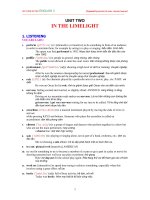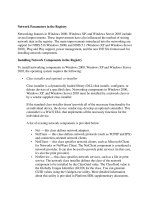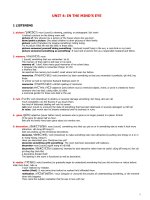Tài liệu FINANCING VACCINES IN THE 21st CENTURY pptx
Bạn đang xem bản rút gọn của tài liệu. Xem và tải ngay bản đầy đủ của tài liệu tại đây (4.48 MB, 264 trang )
Committee on the Evaluation of Vaccine Purchase Financing
in the United States
Board on Health Care Services
THE NATIONAL ACADEMIES PRESS
Washington, D.C.
www.nap.edu
Assuring Access and Availability
FINANCING
VACCINES
IN THE 21ST CENTURY
THE NATIONAL ACADEMIES PRESS 500 Fifth Street, N.W. Washington, DC 20001
NOTICE: The project that is the subject of this report was approved by the Gov-
erning Board of the National Research Council, whose members are drawn from
the councils of the National Academy of Sciences, the National Academy of Engi-
neering, and the Institute of Medicine. The members of the committee responsible
for the report were chosen for their special competences and with regard for ap-
propriate balance.
Support for this project was provided by the Centers of Disease Control and Pre-
vention. The views presented in this report are those of the Institute of Medicine
Committee on the Evaluation of Vaccine Purchase Financing in the United States
and are not necessarily those of the funding agencies.
Library of Congress Cataloging-in-Publication Data
Financing vaccines in the 21st century : assuring access and availability /
Committee on the Evaluation of Vaccine Purchase Financing in the United
States, Board on Health Care Services.
p. ; cm.
Includes bibliographical references.
ISBN 0-309-08979-4 (pbk.)—ISBN 0-309-52619-1 (PDF)
1. Vaccination—United States—Planning. 2. Vaccines—Economic aspects—
United States. 3. Vaccination—Economic aspects—United States. 4.
Vaccination—Government policy—United States.
[DNLM: 1. Mass Immunization—economics—United States. 2. Vaccines—
economics—United States. WA 110 F4818 2003] I. Title: Financing vaccines in
the twenty-first century. II. Institute of Medicine (U.S.). Committee on the
Evaluation of Vaccine Purchase Financing in the United States.
RA638.F54 2003
614.4'7—dc22 2003018817
Additional copies of this report are available from the National Academies Press,
500 Fifth Street, N.W., Lockbox 285, Washington, DC 20055; (800) 624-6242 or (202)
334-3313 (in the Washington metropolitan area); Internet, .
For more information about the Institute of Medicine, visit the IOM home page at:
www.iom.edu.
Copyright 2004 by the National Academy of Sciences. All rights reserved.
Printed in the United States of America.
The serpent has been a symbol of long life, healing, and knowledge among almost
all cultures and religions since the beginning of recorded history. The serpent
adopted as a logotype by the Institute of Medicine is a relief carving from ancient
Greece, now held by the Staatliche Museen in Berlin.
Shaping the Future for Health
“Knowing is not enough; we must apply.
Willing is not enough; we must do.”
—Goethe
The National Academy of Sciences is a private, nonprofit, self-perpetuating soci-
ety of distinguished scholars engaged in scientific and engineering research, dedi-
cated to the furtherance of science and technology and to their use for the general
welfare. Upon the authority of the charter granted to it by the Congress in 1863,
the Academy has a mandate that requires it to advise the federal government on
scientific and technical matters. Dr. Bruce M. Alberts is president of the National
Academy of Sciences.
The National Academy of Engineering was established in 1964, under the charter
of the National Academy of Sciences, as a parallel organization of outstanding
engineers. It is autonomous in its administration and in the selection of its mem-
bers, sharing with the National Academy of Sciences the responsibility for advis-
ing the federal government. The National Academy of Engineering also sponsors
engineering programs aimed at meeting national needs, encourages education and
research, and recognizes the superior achievements of engineers. Dr. Wm. A.
Wulf is president of the National Academy of Engineering.
The Institute of Medicine was established in 1970 by the National Academy of
Sciences to secure the services of eminent members of appropriate professions in
the examination of policy matters pertaining to the health of the public. The Insti-
tute acts under the responsibility given to the National Academy of Sciences by its
congressional charter to be an adviser to the federal government and, upon its
own initiative, to identify issues of medical care, research, and education. Dr.
Harvey V. Fineberg is president of the Institute of Medicine.
The National Research Council was organized by the National Academy of Sci-
ences in 1916 to associate the broad community of science and technology with
the Academy’s purposes of furthering knowledge and advising the federal gov-
ernment. Functioning in accordance with general policies determined by the
Academy, the Council has become the principal operating agency of both the Na-
tional Academy of Sciences and the National Academy of Engineering in provid-
ing services to the government, the public, and the scientific and engineering com-
munities. The Council is administered jointly by both Academies and the Institute
of Medicine. Dr. Bruce M. Alberts and Dr. Wm. A. Wulf are chair and vice chair,
respectively, of the National Research Council.
www.national-academies.org
COMMITTEE ON THE EVALUATION OF VACCINE PURCHASE
FINANCING IN THE UNITED STATES
FRANK A. SLOAN, Ph.D. (Chair), J. Alexander McMahon Professor of
Health Policy and Management, and Professor of Economics, Duke
University, Durham, North Carolina
STEVE BERMAN, M.D., Professor and Head, Section of General
Academic Pediatrics, and Director, Children’s Outcomes Research
Program, University of Colorado School of Medicine and The
Children’s Hospital, Denver, Colorado
DAVID CUTLER, Ph.D., Professor, Department of Economics, Harvard
University, Cambridge, Massachusetts
ERIC FRANCE, M.D., M.S.P.H., Chief of Preventive Medicine, Kaiser
Permanente-Colorado, Denver, Colorado
WILLIAM J. HALL, M.D., Chief, General Medicine/Geriatric Unit,
University of Rochester School of Medicine and Dentistry,
Rochester, New York
DAVID R. JOHNSON, M.D., M.P.H., Deputy Director and Chief
Medical Executive, Michigan Department of Community Health,
Lansing, Michigan
ALISON KEITH, Ph.D., Consultant, Health Economist, Pfizer, Inc.
(retired), Springdale, Utah
JUNE O’NEILL, Ph.D., Professor of Economics and Finance, Zicklin
School of Business, Baruch College, City University of New York,
New York, New York
MARK PAULY, Ph.D., Bendheim Professor and Chair, Health Care
Systems Department, The Wharton School, University of
Pennsylvania, Philadelphia, Pennsylvania
SARA ROSENBAUM, J.D., Hirsh Professor and Chair, Department of
Health Policy, George Washington University Medical Center,
School of Public Health and Health Services, Washington, D.C.
IRIS R. SHANNON, Ph.D., R.N., Health Consultant and Associate
Professor, Health Systems Management, Rush University, Chicago,
Illinois
Committee Staff
Rosemary Chalk, Study Director
Robert Giffin, Ph.D., Senior Program Officer
Nakia Johnson, Senior Project Assistant
Ryan Palugod, Senior Project Assistant
v
Independent Report Reviewers
This report has been reviewed in draft form by individuals chosen for
their diverse perspectives and technical expertise, in accordance with pro-
cedures approved by the National Research Council’s Report Review
Committee. The purpose of this independent review is to provide candid
and critical comments that will assist the institution in making its pub-
lished report as sound as possible and to ensure that the report meets
institutional standards for objectivity, evidence, and responsiveness to the
study charge. The review comments and draft manuscript remain confi-
dential to protect the integrity of the deliberative process. We wish to
thank the following individuals for their review of this report:
WILLIAM V. CORR, Executive Vice President, National Center for
Tobacco-Free Kids, Washington, DC
HELEN DARLING, M.A., President, Washington Business Group on
Health, Washington, DC
SHERRY GLIED, Ph.D., Assistant Professor of Public Health, Colum-
bia University, New York, NY
HENRY G. GRABOWSKI, Ph.D., Professor of Economics and Direc-
tor of the Program in Pharmaceuticals and Health Economics, Duke Uni-
versity, Durham, NC
RUTH J. KATZ, J.D., M.P.H., Associate Dean of Administration, Yale
University, New Haven, CT
TRACY LIEU, M.D., M.P.H., Associate Professor, Department of
Ambulatory Care and Prevention, Harvard University, Boston, MA
vii
viii INDEPENDENT REPORT REVIEWERS
BARBARA D. MATULA, M.P.A., Consultant, Health Care Access
Program, North Carolina Medical Society Foundation, Raleigh, NC
GEORGES PETER, M.D., Professor and Vice-Chair for Faculty Af-
fairs, Department of Pediatrics, Brown Medical School, Providence, RI
JEFFREY L. PLATT, M.D., Professor of Immunology, Mayo Clinic,
Rochester, MN
WILLIAM SCHAFFNER, M.D., Professor and Chairman, Depart-
ment of Preventive Medicine, Vanderbilt University, Nashville, TN
DAVID TAYLOE, JR., M.D., Goldsboro Pediatrics, Goldsboro, NC
THOMAS VERNON, M.D., Executive Director, Medical, Scientific,
and Public Affairs, Merck Vaccine Division, West Point, PA
Although the reviewers listed above have provided many construc-
tive comments and suggestions, they were not asked to endorse the
report’s conclusions or recommendations, nor did they see the final draft
of the report before its release. The review of this report was overseen by
William L. Roper, M.D., M.P.H., Dean of the School of Public Health,
The University of North Carolina at Chapel Hill, and Willard Manning,
Ph.D., Professor, Department of Health Studies, The University of Chicago.
Appointed by the National Research Council and the Institute of Medi-
cine, they were responsible for making certain that an independent
examination of this report was carried out in accordance with institu-
tional procedures and that all review comments were carefully consid-
ered. Responsibility for the final content of this report rests entirely with
the authoring committee and the institution.
ix
Contents
EXECUTIVE SUMMARY 1
1 INTRODUCTION 21
Background, 22
Conceptual Framework for the Study, 26
Study Process, 35
Summing Up, 36
Organization of the Report, 37
2 ORIGINS AND RATIONALE OF IMMUNIZATION POLICY 39
Legislative History of Vaccine Policy, 45
Shared Federal and State Responsibility for Financing, 47
Shared Public and Private Responsibility for Coverage, 49
Public and Private Delivery Systems, 51
Private Vaccine Production, 52
The Setting of National Vaccine Policy, 56
Findings, 61
3 PUBLIC AND PRIVATE INSURANCE COVERAGE 63
Public Insurance Coverage, 66
Private Insurance Coverage, 69
Barriers to a Well-Functioning Immunization Finance System, 73
Findings, 89
x CONTENTS
4 DELIVERY SYSTEMS 91
Delivery of Adult and Childhood Vaccines, 91
The Work of Immunizing, 94
Provider Reimbursement, 98
Barriers to a Well-Functioning Immunization Delivery System, 100
Findings, 105
5 VACCINE SUPPLY 107
Size and Growth of the Vaccine Market, 107
Vaccine Production, 109
Cost Structure, 111
Research and Development, 116
Industry Concentration, 121
Regulation, 126
Pricing, 127
Shortages, 131
Stockpiles, 137
CDC Contracting, 138
Barriers to a Well-Functioning Vaccine Supply System, 139
Findings, 142
6 CONCLUSIONS AND ALTERNATIVE STRATEGIES 145
Conclusions, 146
Alternative Strategies, 151
Weighing the Alternatives, 179
7 RECOMMENDATIONS 183
Recommendations, 185
Final Observations, 210
REFERENCES 211
GLOSSARY 221
APPENDICES
A Recommended Vaccine Schedules (Childhood and Adult) 229
B List of Contributors 235
C Survey of State Vaccine Finance Practices 239
D Overview of Commissioned Papers 241
E Committee and Staff Biographies 243
Tables, Figures, and Boxes
TABLES
1-1 Change in Annual Morbidity from Vaccine-Preventable
Diseases: Prevaccine Baseline and 2002, 24
1-2 Benefit–Cost Ratios for Selected Vaccines, 28
1-3 Prices of Selected U.S. Vaccines: 1980 Versus 2003, 29
1-4 Vaccines for Children Program: CDC Vaccine Price List, 30
2-1 Government Roles in Immunization, 40
3-1 Insurance Coverage for Immunization by Age Group, 2000, 64
3-2 Public Immunization Funding, Fiscal Years 1999 and 2002, 66
3-3 State Vaccine Purchase Financing Systems, 70
3-4 Insurance Coverage for Immunization and Employer-Based
Market Share by Type of Insurance Plan, 71
3-5 Studies of the Impact of Insurance and Cost Sharing on
Immunization Rates, 76
3-6 Adults Considered to Be at High Risk for Influenza or
Pneumococcal Disease, 88
4-1 Proportion of Publicly Purchased Vaccines Administered in
the Private Sector, 93
4-2 Provider Payment for Vaccines and Administration Fees, 98
4-3 Studies on the Impact of Insurance on Referrals, 102
xi
xii TABLES, FIGURES, AND BOXES
5-1 Domestic Producers of Vaccines for the U.S. Market, 110
5-2 Foreign Producers of Vaccines for the U.S. Market, 112
5-3 Deaths from Selected Diseases Not Yet Preventable by
Immunization, 119
5-4 Approved Vaccines Withdrawn from the U.S. Market, 123
5-5 Number of Producers of Selected Vaccines for the U.S.
Market, 2003, 127
5-6 Federal and Private Prices of Vaccines Per Dose, 1983–2002, 130
5-7 Vaccine Supply Status in 2001–2002, 135
5-8 Vaccine Shortages and Their Causes, 136
5-9 Vaccines With and Without Supply Problems, 137
6-1 Summary of Alternative Strategies for Vaccine Purchases, 154
7-1 Legislative Impact of Committee Recommendations, 199
7-2 Proposed Redesign of ACIP Recommendations, 202
FIGURES
1-1 Cumulative vaccine cost trends, 32
2-1 Central role of ACIP in vaccine policy, 58
3-1 Insurance coverage of vaccination, children aged 0–5 (2000), 65
3-2 Insurance coverage of vaccination, adults aged 18–64 (2000), 65
5-1 Federal contract vaccine prices in current dollars, 134
7-1 New vaccine development and subsidy, 188
BOXES
ES-1 Charge to the IOM Committee, 3
1-1 Charge to the IOM Committee, 23
2-1 Vaccine Spillover Effects and Public Good Properties, 42
2-2 Public–Private Collaboration: The Case of DTaP Vaccine, 53
5-1 Vaccine Development and Approval, 115
5-2 Vaccines Expected to Be Developed by 2010, 118
TABLES, FIGURES, AND BOXES xiii
5-3 Vaccine Supply: The Case of DTaP, 125
5-4 Vaccine Purchasing by the Veterans Administration and the
Department of Defense, 129
6-1 Setting Prices for New Vaccines in Advance, 174
7-1 Calculating the Societal Benefits of Vaccines, 192
Assuring Access and Availability
FINANCING
VACCINES
IN THE 21ST CENTURY
1
ABSTRACT
The public–private partnership that has formed the foundation for purchas-
ing and distributing vaccines in the United States over the past 50 years is show-
ing signs of erosion. The existing national immunization system has performed
well in achieving high levels of immunization for children. But difficult new chal-
lenges have emerged, including a growing number of recommended vaccines,
higher prices associated with new vaccines, persistent disparities in immunization
levels, low levels of immunization for adults with chronic illness, the growing
burden of immunization on clinicians, recent shortages in the supply of vaccines,
and the increasing investment required to license and produce new vaccines.
In addition, the vaccine supply system has undergone radical change. More
than 25 companies produced vaccines for the U.S. market in the last 30 years; yet
today only 5 companies produce all vaccines recommended for routine use by
children and adults. Government purchases now account for more than half of
the vaccine market. Government vaccine expenditures are growing rapidly; fund-
ing for the Vaccines for Children entitlement program jumped from $500 million
to $1 billion between 2000 and 2002 with the addition of new vaccine products to
the recommended childhood schedule.
In diagnosing the problems facing the vaccine financing system, the Insti-
tute of Medicine’s Committee on the Evaluation of Vaccine Purchase Financing
in the United States recognized that a strong relationship exists between the sys-
tem for purchasing and administering vaccines and the stability and growth of
the U.S. vaccine supply industry. Although vaccines represent important tools
for disease prevention and have significant social value, they frequently generate
Executive Summary
2 FINANCING VACCINES IN THE 21ST CENTURY
lower revenues than drugs and other health care services, and provide a less at-
tractive opportunity for private investment in the pharmaceutical industry. To
resolve these tensions, the committee recommends strategic reforms that balance
public health goals with the need to provide industry a rate of return that is
adequate to supply current products and also develop new vaccines. The
committee’s principal recommendation is the replacement of existing government
vaccine purchasing programs with a new vaccine insurance mandate, subsidy,
and voucher plan. The mandate would require that all public and private insur-
ance plans include vaccine benefits. The federal government would provide a sub-
sidy to health plans and providers to reimburse their vaccine purchase costs and
administration fees. The federal government would also provide vouchers for un-
insured children and adults to support recommended immunizations from health
care providers of their choice. In formulating this approach, the committee con-
sidered several alternative strategies, which are described in the report.
The committee further recommends changes in the composition and deci-
sion-making procedures of the Advisory Committee on Immunization Practices,
the entity that currently recommends vaccines, to improve the integration of com-
peting objectives within the national immunization system. Finally, the commit-
tee recommends the initiation of a deliberative process, an evaluation study, and
a research agenda to provide data and indicators that can guide future policy and
practice with regard to vaccine financing.
This report presents the results of an evaluation of the financing of
vaccine purchases. The purpose of that evaluation was to design a fi-
nance strategy that can achieve the right balance in assuring access to the
social benefits of vaccines while also encouraging the availability of new
and future vaccine products within the health care system. The study
was prompted by the publication of an earlier Institute of Medicine (IOM)
report, Calling the Shots (IOM, 2000a), which examined the financing of
immunization infrastructure and recommended a substantial increase
($75 million) in the federal immunization grants program to support in-
frastructure development. In framing this new study, the Centers for Dis-
ease Control and Prevention (CDC) asked the IOM to examine what is
known about current vaccine finance arrangements and to identify strat-
egies that could resolve the basic tensions and uncertainties that perme-
ate existing vaccine purchasing systems in the public and private health
care sectors. The Committee on the Evaluation of Vaccine Purchase Fi-
nancing in the United States was formed to conduct this study. The spe-
cific charge to the committee, which was based on questions posed by
CDC, is shown in Box ES-1.
EXECUTIVE SUMMARY 3
BACKGROUND
Immunization represents one of the great triumphs of medical sci-
ence, one of the most distinctive achievements of the American health
care system, and one of the best investments in public health. Vaccines
have acquired a special status within the public and private health sectors
because they convey significant benefits not only to individuals who are
immunized but also to the community at large. Vaccines create a “herd
immunity” that protects those who do not receive the vaccine because of
medical conditions, those who may be too young to receive the vaccine,
those who are not vaccinated because of parental indifference or religious
or philosophical objections to vaccination, and those who face financial or
other barriers to immunization services. By interrupting the spread of
communicable disease, vaccines reduce the number of persons who be-
come infected, diminish the burden of disease, reduce public and private
health care expenditures, and improve the quality of life of the general
population.
The value of a given vaccine is determined by such factors as protec-
tive efficacy, disease incidence, disease outcomes, and costs associated
with its use. Moreover, the costs and benefits of individual vaccines vary
with the assumptions that guide the assessment of financial and social
BOX ES-1
Charge to the IOM Committee
The purpose of the study is to identify financial strategies that are de-
signed to achieve an appropriate balance of roles and responsibilities in
the public and private health sectors, integrate federal and state roles in
supporting the purchase and administration of recommended vaccines for
vulnerable populations, and develop a framework for identifying pricing
strategies that can contribute to achieving current and future national im-
munization goals for children and adults.
The IOM study will develop recommendations to guide federal, state,
and congressional decision-making with respect to the purchase of vac-
cines for the general population, especially underserved groups. The com-
mittee will develop a plan that can assure an adequate supply of current
vaccines and also provide incentives for the development of new vaccine
products. The committee will review factors that influence recent pricing
trends in the vaccine industry, identify current health coverage disparities
and levels of need that affect access to vaccines in the child and adult
populations, and consider the effects of regulatory and licensing proce-
dures on vaccine pricing and vaccine delivery patterns.
4 FINANCING VACCINES IN THE 21ST CENTURY
benefits. Some vaccines produce significant benefits in early childhood;
others provide protection during adolescence or adult life. Some vaccines
are recommended for universal use; others are recommended only for
certain jurisdictions or populations that have specific risk characteristics.
Studies have shown that the ratios of vaccination benefits to costs can
vary substantially—from 27:1 for diphtheria/pertussis (i.e., $27 worth of
benefit for every $1 spent), to 13.5:1 for measles, 4.76:1 for varicella, and
0.68:1–1.1:1 for pneumococcal conjugate.
In general, vaccines are investments that confer significant health and
other social benefits. The delivery of recommended vaccines is now a fun-
damental component of primary health care services for children, and
increasingly for adolescents and adults as well. Record high levels of im-
munization have been achieved for young children; for example, 74 per-
cent of all children now receive the recommended series of vaccines by
age 2. Even so, one in four children under age 2 is not up to date on rec-
ommended vaccines.
The federal government currently purchases between 52 and 55 per-
cent of the childhood vaccines distributed in the United States, primarily
for children who are uninsured or Medicaid-eligible. Nearly 20 doses of
vaccines against 11 diseases are required for childhood immunization, at
a cost of about $400 at the discounted prices available to the public sector
(up to $600 at private-sector prices). This investment strains the ability of
both the public and private sectors to immunize a daily birth cohort of
more than 11,000 babies. Additional funds are required for the adminis-
tration of the vaccines, as well as vaccine shipping and storage costs.
In the 10-year period between 1988 and 1997, public-sector expendi-
tures for vaccine purchases doubled from $100 to $200 per child through
age 6. The cumulative public-sector cost doubled again in less than 5 years
between 1997 and 2001, from $200 to almost $400 per child. The addition
to the recommended childhood schedule of the expensive new pneumo-
coccal conjugate vaccine for infants resulted in a doubling of the budget
between 2000 and 2002 (from $500 million to over $1 billion in 2000) for
the Vaccines for Children (VFC) entitlement—the major government
vaccine purchase program for disadvantaged children. Continued cost
increases can be expected as a result of the array of new vaccines now in
development.
Health officials in both the public and private health care sectors are
concerned about the growing fragmentation of effort within the immuni-
zation system, as well as the increasing number of recommended vac-
cines and the high prices of new vaccines. These factors contribute to gaps
and uncertainties in health plan benefits for immunization, which can lead
in turn to missed opportunities for immunization, greater disparities in
immunization rates, and possible outbreaks of vaccine-preventable dis-
EXECUTIVE SUMMARY 5
ease. Moreover, while rates of adult immunization have improved for
vaccines that prevent influenza and pneumonia, they are still well below
the public health goals established in Healthy People 2010 (U.S. Depart-
ment of Health and Human Services, 2000). Adults with chronic health
conditions (such as heart and lung disease or diabetes) that place them at
high risk for vaccine-preventable disease have particularly low immuni-
zation levels.
A public–private partnership has traditionally shared the costs of
purchasing and administering vaccines for children, but the private con-
tribution to this partnership may be weakening. While most public and
private health plans include vaccine benefits, the scope of those benefits
varies widely by type of insurance product and type of vaccine. Federal
and state regulations have emerged to require certain types of insurance
coverage for some vaccines for children and adults, but the regulatory
effort is uneven and difficult to administer. Furthermore, government
programs that have been created to provide access to vaccines for chil-
dren (such as VFC) have not addressed the needs of older adolescents
and adults, nor have they created incentives for vaccine administration
among health providers.
The uneven nature of health plan vaccine benefits and the limited
data on insurance practices with respect to immunization create signifi-
cant uncertainties in designing national finance strategies for vaccine pur-
chases. The population of underinsured—those who have health care in-
surance that covers major medical expenses but does not include benefits
for vaccines—is a source of increasing concern and uncertainty. Further-
more, some health plans that do include vaccine benefits require out-of-
pocket expenses in the form of high deductibles or copayments.
While some states assure access to vaccines for the underinsured, oth-
ers do not. Some states require immunization coverage in state-regulated
insurance plans; others do not. Some states that once had universal pur-
chase policies (thus providing vaccines to all children) are now reducing
the scope of their benefits.
Recent vaccine shortages that were unprecedented in their scope and
severity, as well as diminishing numbers of vaccine suppliers for the U.S.
market, are early warning signs of other problems that require systemic
remedies to assure a healthy and reliable vaccine supply system. While
temporary production problems appear to have eased, the potential for
disruption remains. The problem of vaccine shortages has raised concerns
about the relationships among the size of the government vaccine market,
low vaccine prices, and the scale of investment in the production of cur-
rent vaccines and the development of new vaccine products. The ability
of the government to negotiate low prices for recommended vaccines is
important to public health agencies and others that are trying to stretch
6 FINANCING VACCINES IN THE 21ST CENTURY
tight budgets to cover both traditional vaccines and a growing array of
new and higher-priced vaccine products. On the other hand, adequate
financial incentives are necessary to sustain private investment in the vac-
cine production and licensing processes if the vaccine industry is to re-
main competitive and have the capacity to innovate within a global vac-
cine market.
Incremental reforms have been offered to solve discrete aspects of the
problems associated with access to and the supply of current vaccines.
For example, the proposed fiscal year 2004 federal budget includes pro-
posals to increase the scope of the safety net, lift vaccine price caps, and
expand the size of vaccine stockpiles. These reforms may provide tempo-
rary relief from acute problems, but the nation still lacks a comprehensive
finance strategy that can adapt to expected increases in both the number
and prices of vaccines, continue to assure access for disadvantaged popu-
lations, and also sustain incentives for private investment in the produc-
tion and licensing of current and future vaccine products.
CONCLUSIONS
Routine immunization for recommended vaccines, especially for chil-
dren, is achieved through a partnership between public health clinics and
private clinicians. In formulating the following conclusions, the committee
focused on aspects of the immunization system that represent important
sources of stress and tension associated with current vaccine
purchase practices. Other aspects of the immunization system (such as
concerns about the quality of the public health infrastructure, vaccine
safety issues, military vaccines, and the role of vaccines in dealing with
bioterrorism) are addressed in other IOM reports (IOM, 2000a,b; 2002a,b,c;
2003).
Conclusion 1: Current public and private financing strategies for
immunization have had substantial success, especially in improv-
ing immunization rates for young children. However, significant
disparities remain in assuring access to recommended vaccines
across geographic and demographic populations.
Despite improvements, current childhood immunization levels (about
74 percent of all 2-year-old children) have not achieved the national health
goal of 80 percent immunization. One in four young children is not up to
date in receiving recommended immunizations.
Substantial variation (almost 20 percent) in immunization rates cur-
rently exists within and across states. Some large urban centers, in par-
ticular, have low immunization rates for children aged 19 to 36 months.
EXECUTIVE SUMMARY 7
The specific causes of these disparities are not well understood, but low
levels of immunization are commonly associated with areas characterized
by a concentration of poverty and populations that frequently move in
and out of safety net programs.
In addition, the disparities between children and adults in the burden
of vaccine–preventable disease are troubling. Although the reported use
of pneumococcal and influenza vaccines among adults aged 65 and older
more than doubled in the period 1988–1995, morbidity and mortality for
both diseases remain significant in this population. Immunization rates
for high-risk adults (aged 18–64) with chronic disease are especially poor:
in 1999, 31.9 percent received an annual influenza vaccination, while only
17.1 percent had ever received a pneumococcal vaccination. The difficul-
ties associated with risk-based strategies (i.e., based on health conditions)
for adults have caused many providers within the health profession to
shift to an age-based strategy to encourage vaccination of adults.
Conclusion 2: Substantial increases can be expected to occur in pub-
lic and private health expenditures as new vaccine products become
available. While these cost increases will be offset by the health
and other social benefits associated with these advances in vaccine
development, the growing costs of vaccines will be increasingly
burdensome to all health sectors. Alternatives to current vaccine
pricing and purchasing programs are required to sustain stable in-
vestment in the development of new vaccine products and attain
their social benefits for all.
Although the costs associated with purchasing and delivering vac-
cines have historically been small, new vaccines will be priced at higher
levels reflecting the scale of investment necessary to bring new products
through the licensing and production processes. The addition of new vac-
cines to the recommended schedule and the higher costs associated with
newer vaccine products have placed tremendous stress on safety net pro-
grams that are already straining to achieve public health goals. Higher
vaccine prices can be expected to exacerbate such problems as uneven
distribution patterns, delays in the vaccine price negotiation processes for
federal and state contracts, and continued fragmentation in the scope of
vaccine benefits included in public and private health plans. An increased
burden on public health clinics also occurs when private health plans re-
duce reimbursements for recommended vaccines in the face of higher
costs. This burden places substantial stress on public health budgets and
interferes with the ability to provide vaccines to traditional safety net
populations, as well as those who lack vaccine benefits within their health
plans.
8 FINANCING VACCINES IN THE 21ST CENTURY
It should be noted that vaccines provide a net long-term savings in
health care costs. Over time, vaccines should lead to a diminution in what
would otherwise be spent on health care. But certain sectors (such as state
and federal health agencies) will bear substantial short-term costs of ac-
quiring and delivering vaccines.
Increases in the budgets of government vaccine programs should be
seen as acceptable, indeed desirable, insofar as new vaccines can offer
substantial public health benefits. What is missing in the array of current
vaccine purchasing programs is a clear and deliberate strategy that the
government can use to stabilize and assure adequate rates of return on
future private investments in vaccine development. While the true costs
of innovation remain unknown, government pricing systems and bulk
purchases alone appear to provide insufficient incentives, according to
industry sources, given the higher production costs and uncertainties as-
sociated with vaccine development and the tendency to push down prices
in the public sector.
Conclusion 3: Many young children, adolescents, and high-risk
adults have no or limited insurance for recommended vaccines.
Gaps and fragmentation in insurance benefits create barriers for
both vulnerable populations and clinicians that can contribute to
lower immunization rates.
As noted above, many individuals are underinsured—their health
insurance benefits do not include coverage for immunization. Estimates
of underinsurance among children vary from 5 to 14 percent. Others have
insurance policies that require individuals to share the costs of vaccines in
the form of high deductibles and copayments. Still others, such as Medi-
care beneficiaries, are covered for certain vaccines but not others. Persons
who face such financial barriers are less likely to receive routine immuni-
zations in their medical homes and may fail to receive certain immuniza-
tions at all.
Although most large public and private health plans include vaccine
benefits, signs of slippage are occurring within the scope of vaccine ben-
efits offered by small businesses and other large subscribers, such as pub-
lic employee health plans. The omission of or limitations on vaccine ben-
efits in health plans, coupled with increasing deductibles and copayments,
create gaps that existing safety net programs cannot easily fill. The result
is increasing fragmentation and administrative barriers that interfere with
the timely delivery of vaccines within routine health care services.
The multifaceted eligibility determinations associated with the cur-
rent fragmented system of public and private vaccine benefits impose sub-
stantial burdens on clinicians. Clinicians must determine whether the









